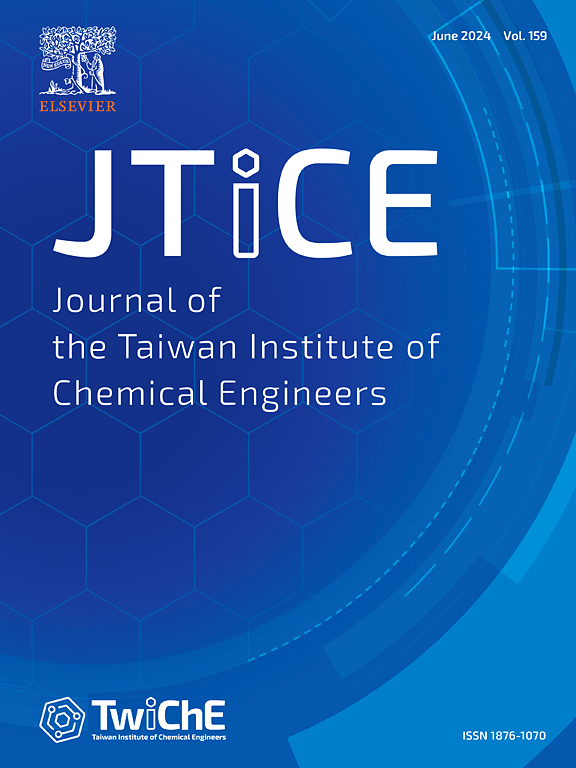非均相z型CuO/ZnO气凝胶光催化剂用于光催化降解有机染料
IF 5.5
3区 工程技术
Q1 ENGINEERING, CHEMICAL
Journal of the Taiwan Institute of Chemical Engineers
Pub Date : 2025-07-10
DOI:10.1016/j.jtice.2025.106281
引用次数: 0
摘要
虽然光催化是一种有效的、环保的降解持久性有机污染物的技术,但制备具有高光催化性能、低成本和合理可回收性的高效光催化剂是一个主要问题。方法采用环氧化物凝胶法和光沉积法合成了z型CuO/ZnO气凝胶(CuO/ZnO AG),并将其作为光催化剂用于水中罗丹明B染料(RhB)的光催化降解。在ZnO AG表面光沉积CuO明显降低了电子与空穴的复合速率,而20wt . %是CuO的最佳负载量。当CuO/ZnO为20 wt. %时,RhB在20 min内完全降解,反应的准一级速率常数(k)为0.0274 min - 1。结果表明,虽然羟基(•OH)和超氧(•O2)自由基都有助于光催化系统的性能,但•OH自由基对降解RhB的贡献要比•O2毒血症高得多。同时,可重复使用性测试表明,该材料可重复使用至少四次,而光催化活性没有明显下降。本文章由计算机程序翻译,如有差异,请以英文原文为准。

Heterogeneous Z-scheme CuO/ZnO aerogel photocatalyst for photocatalytic degradation of organic dye
Background
Although photocatalysis is an effective and eco-friendly technique for the degradation of persistent organic pollutants, fabricating an efficient photocatalyst with high photocatalytic performance, low cost, and reasonable recyclability is a major problem.
Methods
In this work, we synthesized Z-scheme CuO/ZnO aerogels (CuO/ZnO AG) via epoxide-triggered gelation and photo-deposition methods and used the materials as photocatalysts for the photocatalytic degradation of rhodamine B dye (RhB) in water. While the photodeposition of CuO on the surface of ZnO AG evidently decreased the recombination rate of electrons and holes, 20 wt. % was the optimum loading amount of CuO.
Significant findings
Over 20 wt. % CuO/ZnO AG, complete degradation of RhB was achieved within just 20 min with the reaction possessing a pseudo-first-order rate constant (k) of 0.0274 min–1. It was revealed that although both hydroxyl (•OH) and superoxide (•O2⁻) radicals contributed to the performance of the photocatalytic system, the contribution of •OH radicals in degrading RhB was much higher than •O2⁻. Meanwhile, the reusability test showed that the material can be reused for the reaction for at least four runs without a significant decrease in photocatalytic activity.
求助全文
通过发布文献求助,成功后即可免费获取论文全文。
去求助
来源期刊
CiteScore
9.10
自引率
14.00%
发文量
362
审稿时长
35 days
期刊介绍:
Journal of the Taiwan Institute of Chemical Engineers (formerly known as Journal of the Chinese Institute of Chemical Engineers) publishes original works, from fundamental principles to practical applications, in the broad field of chemical engineering with special focus on three aspects: Chemical and Biomolecular Science and Technology, Energy and Environmental Science and Technology, and Materials Science and Technology. Authors should choose for their manuscript an appropriate aspect section and a few related classifications when submitting to the journal online.

 求助内容:
求助内容: 应助结果提醒方式:
应助结果提醒方式:


